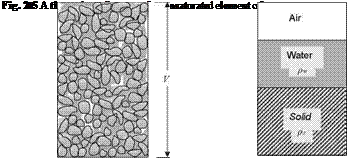Porosity
Porosity is defined as the space inside a rock or sediment (soil), consisting of pores. The total volume of pores is defined as the total porosity. For water, only those pores that are interconnected are important. The interconnected part of the pore system is defined as the effective porosity. The porosity can be described as a three phase system comprising solids, water (liquid) and air (gas), see Fig. 2.5.
The definition of porosity, и, of an aggregate skeleton is the ratio of volume of voids and its bulk volume or:
n = V (m3/m3) (2.6)
 |
|
Void ratio, e, is, on the other hand, defined as the ratio of the same volume of voids but now over its aggregate volume or:
The porosity represents the total amount in a unit volume that can be filled with water. The volumetric water content, в, is defined as the volume of water of a specific element to its total volume or:
в = Vw (m3/m3) (2.9)
and gives therefore the actual fraction of water in the pores. It is therefore obvious that the volumetric water content must lie within the range 0 < в < n.
The gravimetric water content, w (also referred to as the gravimetric moisture content), is on the other hand defined as the ratio of mass of water of an element to its mass of the solids or
![]() mw
mw
w = (kg/kg)
ms
Gravimetric water content is a much more commonly used measure than the volumetric water content. Therefore, unless stated otherwise or as required by the context, the gravimetric water content is indicated by the short form ‘water content’.
There is a simple relationship between the gravimetric water content, w, and the volumetric water content, в:
|
e = V (m3/m3) A simple relationship exists between the porosity and the void ratio, that is: Vv V n e = = ^ n = V – Vv 1 – V 1 – n 1 + e |
![]()
W mw m w ‘ g Pw ‘ Vw pw в
ms ms ■ g pd ■ V pd
where pw is the water density, pd is the dry density of the material and g is the acceleration due to gravity. The degree of water saturation is the volume of water per volume of void space, or:
The saturation range becomes, therefore 0 < Sr < 1 (100%).
Porosity of a geological material can change with time. According to their origins two types of porosity can be recognized, that is a primary and secondary porosity. The primary porosity refers to the original porosity of the material where the secondary porosity refers to the portion of the total porosity resulting from diagenetic processes such as dissolution, post compaction, cementation or grain breakage.






Leave a reply